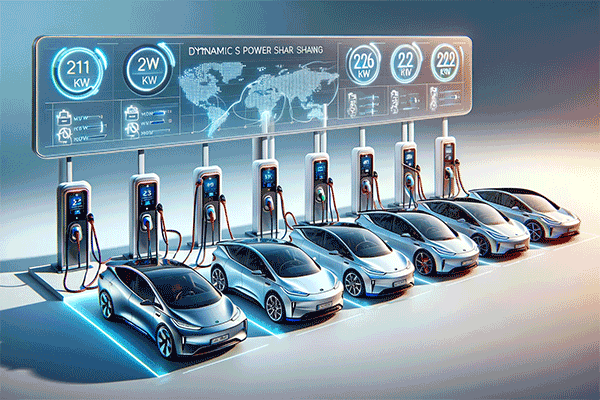When an electric car is plugged to a DC charger, the car sends a message to the charger, requesting a specific amount of power. The charger starts the charging session based on this request.
The charging curves of electric passenger cars are strongly declining by nature. If the charging curves were more stable throughout the charging session, the need for dynamic charging would be smaller. In other words: if the cars would ask for a steady amount of power throughout the charging session, there would be no need for dynamic charging.
The charging curves of electric vehicles also massively differs model to model, with only a few electric cars have a steadily decreasing charging curve. There are also some electric car models on the market with very high charging capacity. The problem, however, is that there are only a few chargers providing equal charging power. Plus, even the most powerful electric cars attain maximum power only for a short period of time.
Thus, all electric cars on the market request a declining amount of power during a fast-charging session, creating the need for dynamic charging. In practice, the charging power requested by a car when starting the charging session can be over 10 times greater than by the end of the charging session. This means that the charger should be able to change the configuration during charging sessions.
In the DC charging solutions provided by SETEC POWER the charging set up is configured throughout the charging session to match with the declining power requested by the car.

Benefits of dynamic EV charging for the charging operators
The dynamic charging makes it easier to install multiple charging points in the same area, as the charging capacity can be shared. For charging sites operators, this means that a larger proportion of the kilowatts purchased is in use, thus the charging capacity ratio is better than with single chargers.
With dynamic charging the charging operator does not need to invest to the charging capacity that is needed at the busiest days of the year. Instead, the charging capacity needed at one charging station can be evaluated to serve an adequate power level for several electric cars most of the time. For example, at a charging station designed for e.g., 8 cars the cars never receive the ultimate maximum power asked by the cars simultaneously. Yet the cars will always get enough power to maintain a smooth and fast charging session.
Dynamic charging also allows the so-called priority charging. Priority can come in many ways. In cities, priority can be determined, for example, by vehicle category: electric buses may have higher priority than taxis, taxis have higher priority than passenger cars, and so on. Another way to determine the priority is so called “first in first out” model. The common factor is that the charging system controls the priority automatically.
The benefit of dynamic EV charging for the electric car drivers
In charging areas with several charging stations and charging outputs, the dynamic charging means that the power released from the charging session of the electric car A can be transferred to the electric car B. This transfer is made simultaneously as the electric car A asks less and less power towards the end of the charging session. The cars are set in the queue automatically when plugged to the charger and system knows in which order the released power will be distributed to other cars.
In today’s eco-conscious and EV-centric world, Load Management is not just a smart business move—it’s a strategic imperative. By optimizing power usage, operators not only reduce their operating costs but also contribute to environmental sustainability. This approach positions them for greater efficiency, increased profitability, and a stronger competitive position in the rapidly growing EV market.














